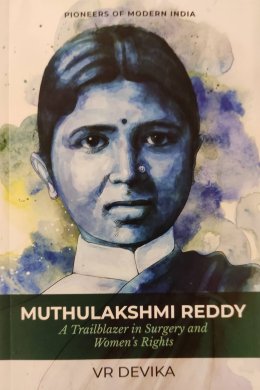
|   |

|   |
Muthulakshmi Reddy - A Trailblazer in Surgery and Women's Rights - Srinivasaraghavan NC e-mail: srinivas.rgvn@gmail.com September 22, 2022  I read the book 'Muthulakshmi Reddy - A Trailblazer in Surgery and Women's Rights' by V.R. Devika and I have to say it was a highly engaging biography that was simple to read and process. Those of us who know Dr. Devika are aware of the hard work that she has put in for this book, the research for which began about four decades ago. Having attended many of her online talks, I was already quite well informed on Dr. Muthulakshmi Reddy and this book provided a more extensive view of things I had pondered about while listening to Dr. Devika. Dr. Muthulakshmi Reddy was a multi-hued personality and I am sure her life and work were boundlessly difficult to document. But the book neatly arranges events in a breezy chronological fashion - starting from Muthulakshmi's early life as the daughter of Chandrammal and Narayanasami Iyer, her struggles to obtain education, the conflict within herself to hold on to her identity as someone from a hereditary art family who did not want to continue the family tradition and so on - her life as a whole is quite inspiring and interesting. The story of how Narayanasami Iyer stood behind her entirely like a rock makes one think how progressive this particular gentleman must have been for his times. Of course we all know that Dr. Reddy was a pioneer when it comes to several things like being the first girl student in a school meant for boys, the first Indian woman surgeon, the first woman member of legislature, etc. The most important facts of her life that we do not know are related to how she reached this great status and the kind of social scrutiny she faced being a woman, and most importantly a woman from a hereditary art family. Understanding what all she went through to achieve all that she did is essential to appreciate the contributions of Dr.Reddy to all the fields that she brought about radical changes in, and that is what distinguishes this biography from others - the amount of effort put in by the author to personally highlight numerous aspects definitely gives the book a distinct touch. For instance, how Elizabeth Garrett Anderson (the first woman to qualify as a physician in Britain) filled Muthulakshmi's heart with hope and possibility to take on the challenges as a woman medical professional. The conversations that Muthulakshmi had with her father are all quite profound and are worth reading over and over again. Muthulakshmi's wedding with Sundaram Reddy, an event anticipated fervently by her mother Chandrammal was unsurprisingly quite ahead of its times as it was a Brahmo Samaj marriage, designed keeping in mind the bent of the couple towards the Theosophical Society and the Justice Party, as the author notes. The event represented Muthulakshmi's balanced adherence to her life's principles while not completely discarding her mother Chandrammal's wish to choose an auspicious date and insisting on lighting a lamp in an otherwise ritual-less marriage. There are many happenings in Reddy's life that are relatable and this was one event I really found interesting. I don't wish to spoil the book for those who have not read it yet and so I am compelling myself not to quote a lot of other things from the book that I found fulfilling. The biggest takeaway for me from this book was the sheer grit and determination with which Muthulakshmi chose to bring about change when she witnessed several social abominations during her lifetime. I think many of us wish to change the world in our own ways but certainly not all of us will be able to achieve this as instantaneously and successfully as her. After all, she wished to break social norms and be one of the first women in the country (from her caste location) to get well-educated and she achieved it! She saw with her own eyes the problems associated with infant marriage and she demanded that it be abolished through her involvement with the WIA (Women's Indian Association)! Perhaps every obstacle and setback that she faced throughout her life and career was destined to happen so that she would strongly fight back with a spirit that would permanently impact the lives of the future generations! The most poignant moment in the book was the demise of Muthulakshmi's beloved sister Sundarambal due to cancer, as narrated by her son Krishnamurthi. This certainly must have been Dr. Reddy's trigger to set up the Cancer Institute, one of the most groundbreaking medical institutions in the history of this country that has transformed the lives of millions of cancer patients, especially those from the lower economic strata. Kudos to Dr. Devika for writing about this pivotal moment with such passion and emotion. On the contentious Devadasi Abolition Bill, which is the most talked-about topic in the classical dance world today, I have done quite a lot of reading and research. I have also spoken to diverse members of hereditary dancing communities who have expressed their viewpoints, both in favour of and against this bill and the consequences that they have had to face as a result of this controversial bill. All I can say is, the debates are endless and I would like to take a neutral stance here. Having read about Dr. Reddy, Muvalur Ramamirthammal, E Krishna Iyer, Balasaraswati, Rukmini Devi and several other great personalities who belonged to that period, all I can say is, each of them were steadfast in their efforts to do what they believed was right. While we must be conscious of the contributions of hereditary dancing communities and make continuing efforts for their acknowledgement and representation, it is up to us to be cognizant of the unique contributions of these great personalities and the circumstances that shaped their thinking and ideals. The establishing of Avvai Home by Dr. Muthulakshmi Reddy was path-breaking and revolutionary in its own unique way. Having grown up near Avvai Home and walking past it every day to go to my own school, I realized how we need to be aware of important institutions in our immediate vicinity and the events that shaped the founding of these institutions. These are not mere bus stops and geographical landmarks. I would like to congratulate and thank the author Dr.V.R. Devika for educating us all continuously and passionately on Dr. Muthulakshmi Reddy. As I have already said, she is someone who is incredibly accessible and open to any kind of conversations on topics such as these. Our Facebook chat history would reveal the kind of discussions and debates that we have had on a number of topics now elaborated in this book regarding dance history. At that time, I did not fully comprehend some of Dr. Devika's points (although I knew where she came from) but after reading this book, I should certainly say I have been enlightened on many other facets that I did not consider carefully or do enough research about. Equipping yourself with this book will help you gain clarity and perspective on some crucial events that are a part of classical dance history. It will also aid you in learning deeply about this towering personality. It was a thorough pleasure to read and write about this book! It was one of the few books I finished quickly without taking many breaks, and I am someone who has dozens of half-read books on my bookshelf!  Currently based in Mumbai, Srinivasaraghavan is a great rasika of classical music and dance. He plays the veena and is a finance professional but in his spare time, he writes articles for newspapers and magazines like The Hindu and Vaak on art and culture. Post your comment Please provide your name and email id when you use the Anonymous / blog profile to post a comment. All appropriate comments posted in the blog will also be featured in the site. |